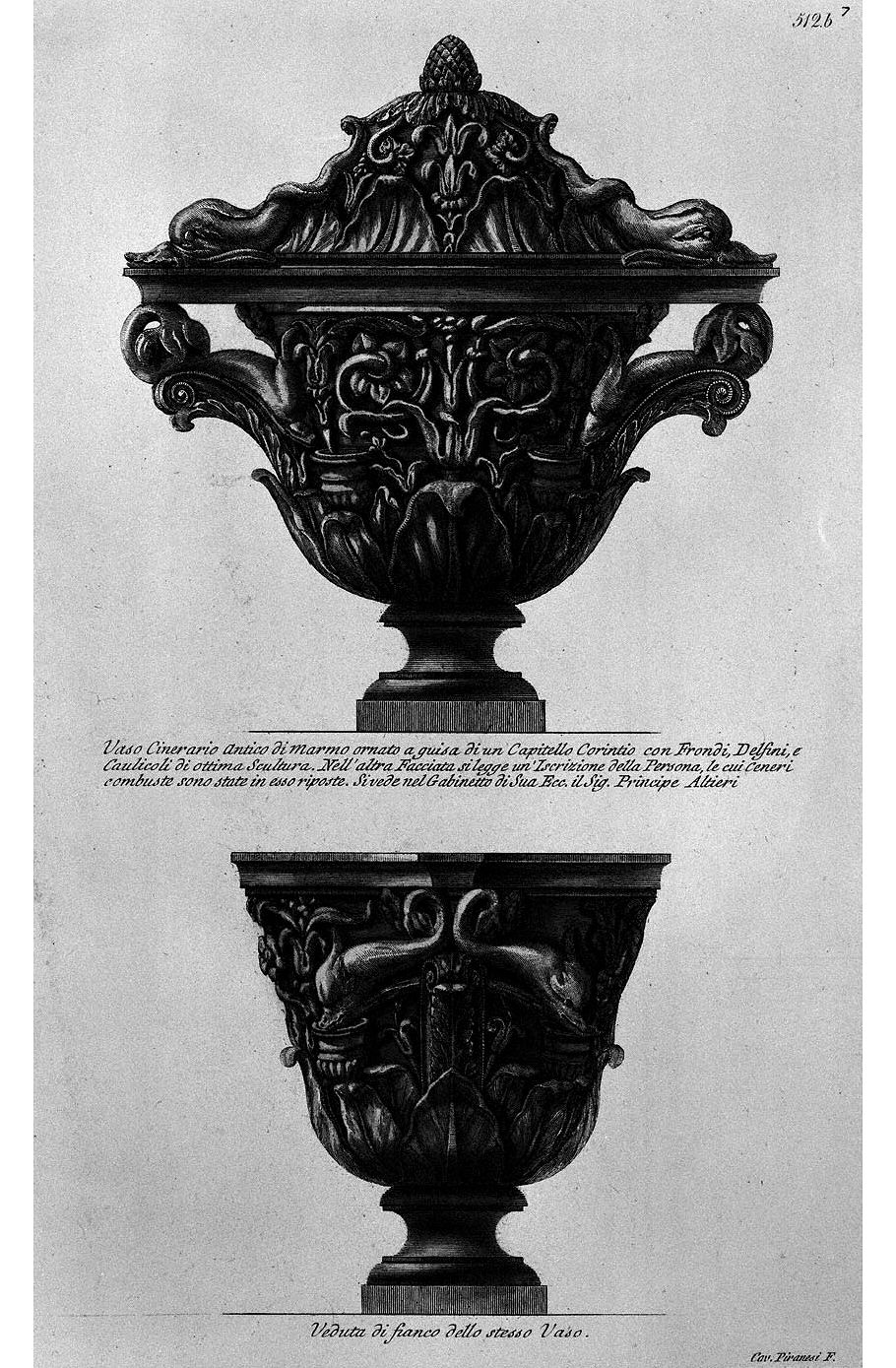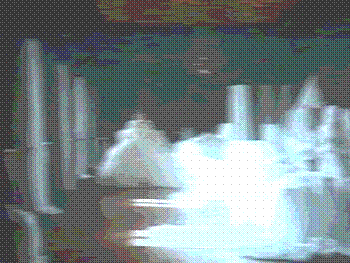17 January 395
Death of Theodosius
17 January 1706
Birth of Benjamin Franklin
17 January 1778 Saturday
Vases, Candelabra, Grave Stones, Sarcophagi. Tripods, Lamps and Ancient Ornaments volume I

Marble cinerary vase decorated as a Corinthian capital.
Ancient Marble Cinerary Vase decorated in the manner of a Corinthian Capital with Fronds, Dolphins, and Caulicoli of excellent Sculpture. On the other facade you can read an inscription of the person whose burnt ashes have been placed in it. It can be seen in the Cabinet of His Exc. Prince Altieri
Side view of the same Vase.
Cav. Piranesi F.
17 January 1812 Friday

Waking this morning I found myself very sore in my left ankle or rather at the lower end of the fibula and a strain at the connection ..... tibia with the cond.... of the .. ........ I could scarcely move in bed--about 11 with the help of SL I rose and dressed myself, with difficulty descended to the parlour. Wrote a note to D. Glass[?] who visited me between 12 & 1. Saw my wound; refused to bleed me in the arm, recommended topical bleeding by leeches and abstinence for 2 or 3 days in stead of Phlebotomy--I acquiesced. I found my son-in-law had company invited to dinner and had made a handsome preparation for them. His mother, brother and sister Johanna, Charles L., Benjamin Warner, Jeremiah Thompson, and Thomas Collins (son of Isaac) of New York. My daughter S. had barely time to dress my wound before they came, yet a handsome dinner was served up about 2 PM. I confined myself to vegetables except 4 Oysters out of the sauce prepared for a turkey and rockfish broth. We had some pleasant conversation on several subjects of which chemistry was one--the company departed, soon after which my brother SR F. came to see my and spent about an hour. About 6 G. Seitg who SL had found to be the only person in the city who had a sufficient quantity of leeched to keep up his profession, attended me and soon began the operation which (having never seen it before) I will slightly describe--he called for a foot tub, one was produced of about common size, a pitcher of hot and another of cold water, they came. He produced two tin canisters apparently of a pint and quart measures, one contained his leeches which he emptied into the tub having about an inch depth of tepid water. They seemed very lively. My foot was set into it and expected they would lay hold of me, but no such thing. He produced a lasnet[?], bound a thread around the outer joint of his finger, pricked it and squeezing out the blood anointed the place where the leeches were to suck with it. Then filling a small glass with a dozen of them he set the mouths on the blood[?] place and held it there. The leeches were not hungry but they began to attach themselves to my skin thus smeared with blood. The pain they excited was trifling, but it was accompanied by a sensation which passing from the nervous papilla on the skin entered my flesh following the course of ascent to the larger branches and occasioned such a thrilling or titillating [a word in Greek] as created an involuntary motion of the whole limb, not unlike the returning circulation in the capillary vessels after a stoppage of it by extreme cold, or by a close pressure upon the vessels which occasion what is vulgarly called the foot falling asleep. The process continued 2 1/2 hours during which the same sensations were continually repeating by fresh leeches attaching themselves and when full hopping off until 44 of these slender beings about 1 1/2 inches long had filled themselves with my blood and fell fully drunk into the water in the tub where they were almost motionless. The operator picked them up as they fell and put them into the second tin vessel till the whole process was finished when he poured them into a cream colored basin from whence he counted them back into the tin--they were so distended with blood as to shed perhaps a gill[?] of it into the basin during the counting them. The operater informed me that he calculated upon their drawing 20 ounces of blood per[?] dozen leeches and from the change of their bulk before and after sucking, this appears not unlikely. After counting them out he charged me $5.50 for 44 leeches, 12 1/2 cents each--I paid him without reluctance at the price. I considered that he must have considerable trouble first to catch the animal, 2nd to keep them alive till their use was called for, 3rd to attend with them, sit on a low stool, exercise his patience and skill for 2 1/2 hours, wash my limb with his sponge, put on my stocking, thank me for paying him for it, and wish that he had pleased me enough to engage me to employ him again if I wanted him, or to recommend him to others. The like skill and patience in several professions that I know of is often more copiously rewarded. Let Law, Physics, Divinity, Merchandise consider this if ever they meet their page -- About 10 I was put to bed with less difficulty than I expected. The leeches having drawn away a considerable quantity of the extravagated[?] blood -- I dropped to sleep.
17 January 1996
Piranesian gigantism
Piranesi's Campo Marzio is full of gigantic plans that are on a scale virtually unrealized in actual built architecture. In simple terms, this overuse of size can represent Piranesi's wish to express the grandness of ancient Rome. Beyond that, it is at this point difficult to make any other interpretation. The real issue seems to be that when so many gigantic plans are seen together, the sense of actual scale is lost. The large plans themselves quite naturally are in turn perceived as buildings that are only something like half their actual size. I think this normal misinterpretation of scale is part of the general enigma that the plan of the Campo Marzio conjures up. The plan seems to have multiple layers of unfathomability, and the ambiguity of scale is indeed one of these layers.
1fathom 1 a obs : a full stretch of the arms in a straight line; also : GRASP, REACH b : intellectual grasp, penetration or profundity : COMPREHENSION 2 a : a unit of length equal to 6 feet based on the distance between finger tips of a man's outstretched arms and used esp. for measuring the depth of water -- sometimes used in the singular when qualified by a number b archaic : any of several units of length varying around 5 and 51/2 feet
2fathom 1 archaic : to encircle (as for measuring) with outstretched arms 2 a : to measure by a sounding line b : to penetrate (as a mystery) and come to understand : comprehend where one had not understood previously : get to the bottom of ~ vi : to take soundings; also : PROBE, INVESTIGATE
fathomable 1 : that can be sounded 2 : capable of being comprehended
unfathomable a : INCOMPREHENSIBLE, INSCRUTABLE b : IMMEASURABLE, IMPENETRABLE
unfathomed 1 : not fathomed : UNSOUNDED 2 : UNDETERMINED, IMMENSE
The gigantism of Piranesi's Campo Marzio becomes perfectly evident when it is compared with other urban plans at the same scale. I have already done some comparative analysis between the Campo Marzio and parts of Center City Philadelphia, particularly the area around the Philadelphia Museum of Art because that building and the plan of the Benj. Franklin Parkway are themselves, in general, fine examples of an urban design gigantism practiced in America in the early twentieth century. I will have to do more drawings that show greater amounts of area, and I shall perhaps also compose some overlay drawings (meaning superimposed plans).
If anything, this exercise would be a lesson in scale and, in particular, gigantic scale. It could perhaps lead to a better understanding of Piranesi's intention and his ideas on urbanism, and it might also lead to a fine understanding of urban scale in general, where the Campo Marzio may actually shed some light on the urban situation of some actual cities, in this case, Philadelphia.
17 January 2002
1606 years ago today (in Milan)
The following excerpt is from F. Homes Dudden, The Life and Times of St. Ambrose (Oxford: Clarendon Press, 1935), pp. 438-9.
Meanwhile for the Emperor at Milan the sands were rapidly running out. The anxiety and fatigue of the recent campaign had proved too severe even for his strong constitution. He was taken ill with a dropsy. A spell of exceptionally inclement weather may have aggravated his malady. Earthquake shocks were felt, incessant fogs shrouded the city in gloom, and for weeks together the rain dripped monotonously. Amid this melancholy dusk and dampness Theodosius grew steadily weaker, and, recollecting the prophecy of John of Lycopolis, became convinced that he would not recover. His remaining energy was applied to the business of providing for the future of the Empire. He arranged that Arcadius should rule the Eastern part and Honorius the Western, and nominated Stilicho though not formally by a legal instrument--as guardian of the two inexperienced Augusti. For his sons he dictated an instruction, in which he earnestly admonished them to be zealous for religion; 'for it is by this', he said, 'that wars are ended, victories are obtained, and peace is secured'. He gave directions for the proclamation of an amnesty to those who had taken arms against him in the recent war, and ordered the recession of a tax which he had promised, but had hitherto neglected, to abolish. By the time that these matters were settled, the Emperor's strength was almost exhausted. The pleasurable excitement of welcoming his younger son on his arrival in Milan produced a temporary rally. Indeed he felt so much better that he gave orders for an exhibition of games in the Hippodrome, and himself watched the morning races from the imperial box. After the dinner-interval, however, he became violently ill, and sent Honorius to represent him at the races in the afternoon. He died in the course of the ensuing night, on the 17th of January, A.D. 395, being then (as seems probable) only in the fiftieth year of his age, and having reigned sixteen years all but two days. Ambrose was with him at the end, and testifies that his last thoughts were for the welfare of the Churches.
It was decided that the corpse should be conveyed to Constantinople, and there interred in the ornate Church of the Apostles. [Here Theodosius was buried on the 8th of November.] First, however, it was embalmed, and for forty days lay in state on a lofty purple-draped couch in the atrium of the palace at Milan. On the fortieth day--Sunday the 25th of February, A.D. 395--a solemn Eucharist was celebrated in the cathedrals and, in the presence of Honorius and the general staff, Ambrose pronounced the funeral oration.
more on Ambrose and Theodosius, etc.
ps (17 January 2002)
I found out about the TYPE quite by accident. Just over a month ago I was at Philadelphia's Free Library's main branch looking up information on Santa Croce in Gerusalemme (which was in one of the volumes published by the Vatican entitled Basilicum something something something.) The book I wanted had to be gotten from a non-public section of the library, and while I was waiting I noticed a book within the new art books display--The Geometry of Love. It turned out that this book is all about the church St. Agnes Outside the Walls, Rome, and I borrowed the book. Although St. Agnes Outside the Walls is one of the original Constantinian Basilicas from the early 4th century, the church was rebuilt under Pope Honorius in the middle of the 7th century. Honorius was pope when Constantine III issued the TYPE, and this historic episode is related briefly in The Geometry of Love.
Just to make public note of it, it was actually during my doing research on St. Agnes (the person) on 1 April 1999 that first led me to St. Helena, a person who up until then I knew absolutely nothing about.
1 April 1999 was Holy Thursday, and a few times that day I though of a departed friend, R. David Schimitt, who died 1 April 1995 (which was Good Friday that year). Dave was an architect, and during our school years together he did an analysis of Santa Costanza, Rome, the mausoleum of Constantine's daughter Constantina which was attached to the original Basilica of St. Agnes (outside the walls). Dave was also a hemophiliac, received HIV tainted blood in 1981(!), and ultimately died of AIDS. I still occasionally see Dave's wife and daughter.
This morning while doing further reading on St. Ambrose I found out the following:
"On his last day, which was Good Friday, he remained continuously in prayer from five o'clock in the afternoon. He lay with his outstretched out in the form of the cross; his lips moved but no words were audible. Hour after hour went by. ...
"Ambrose died very early in the morning of Easter Eve, the 4th of April, A.D. 397, being about fifty-eight years old, and having governed the Church of Milan for twenty-three years and four months.
17 January 2006
17 January 395, 1706, 2006
17 January 395
the death of Theodosius
17 January 1706
the birth of Benjamin Franklin
17 January 2006
the end of Leaving Obscurity Behind
the 2005 Horace Trumbauer Architecture Fan Club Convention
Who knows what else was going on in Boston 300 years ago today, but 1611 years ago in Milan there were "exhibitions of games in the Hippodrome" [de Spectaculis] in the morning and afternoon, in honor of the arrival of Honorius, the younger son of Theodosius.
The Benjamin Franklin Parkway in Philadelphia reenacts the axis of life as delineated by Piranesi within the Ichnographia Campus Martius, and it is at this overlay where Theodosius and Franklin now cross paths, with Trumbauer right there too at the Free Library of Philadelphia.
Honorius' first wife Maria, whose sarcophagus Piranesi used to begin Il Campo Marzio, is presently married to Otto, King of Bavaria, who is now thrilled to see that his production of Leaving Obscurity Behind manifest a happy success.
17 January 2009


17 January 2023 Tuesday
unedited:
I was telling JP about the significance of Theodosius, primarily as the Roman emperor to have rendered all forms of paganism illegal, and thereby establishing Christianity as the empire's only legal religion. Also how Theodosius was the last sole emperor of the Roman Empire, the last in the line of new sole emperors began with Constantine, who was also the first Roman emperor to sanction Christianity. JP brought up Judaism, so I brought up how the [second] Temple of Jerusalem was destroyed under the emperor Titus in the year 70, and that almost 300 years later the emperor Julian, a late son-in-law of Constantine's attempted a rebuilding of the Temple of Jerusalem, hence Julian the Apostate. Then I threw in the Helena's finding of the True Cross was very likely an imperial hoax. That surprised, and even a little shocked JP, but the conversation was ending anyway.
|